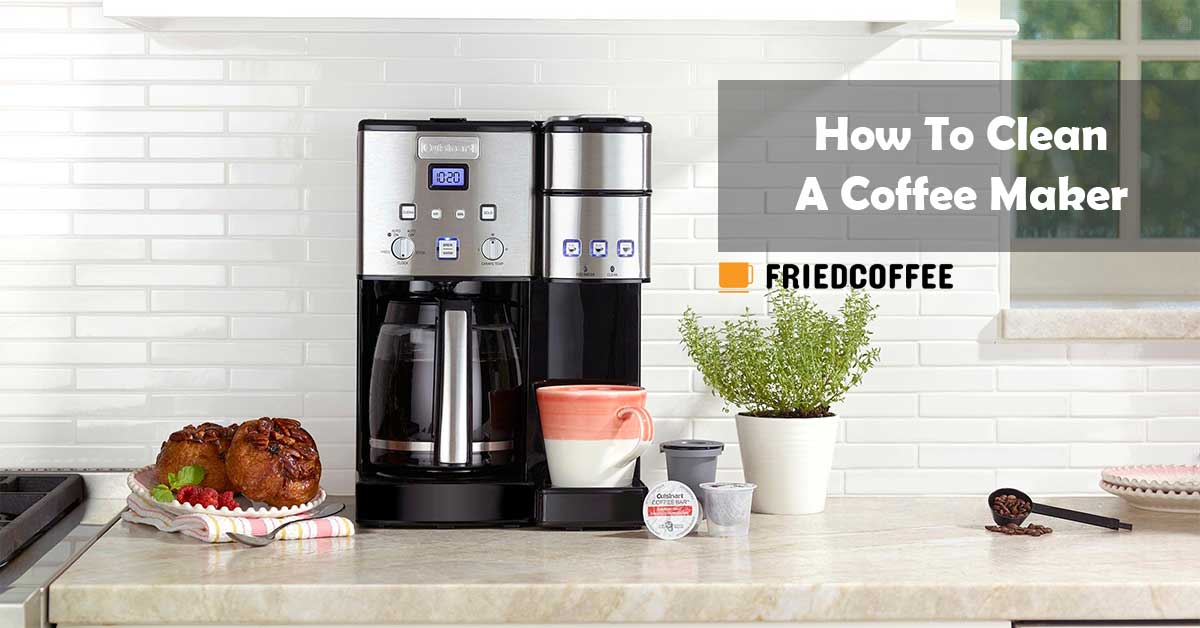Your coffee tastes bitter – Your coffee maker has some foul smell – Or there are some strange sounds with your machine, probably, your machine needs some cleanup. Don’t worry as you are among the 85% of Americans who brew coffee at home and are stuck at how to clean it thoroughly. Well, we are going to tell you the best method for that, but let’s first understand why is it important to clean a coffeemaker.

Why is Cleaning a Coffee Maker So Important
When we think of germs and bacteria in the kitchen, a coffee maker is often skipped, and that’s one of the biggest mistakes. In actuality, it’s one of the highest germicide spots at home, and sometimes and the spread can be even more than that of a bathroom. The following are some of the points directly linked with clean up –
- Better Coffee taste – No one would like the previous month’s leftovers in today’s coffee, ensure that you clean your coffee maker every 30 days. Oil residue from coffee beans can build up; cleaning prevents off-flavors from contaminating your coffee.
- Durable – Regular cleaning prevents water calcium deposits, which can reduce a coffee maker’s life, from accumulating in the heating unit.
- Clean and Dry – Discard wet grounds after brewing and don’t let them sit in the filter basket all day. Leave the lid up too after washing to ensure a clean, dry environment.
- Coffee Windows indicator – In some coffee maker reservoirs or coffee pots, there is a coffee level window that shows how many cups of coffee are remaining. Regular cleaning prevents you from thinking there’s coffee left when there isn’t.
- Shine On – Tannin in a coffee can cause brownish stains to develop on the internal area of the coffee pots. Regular cleaning helps to keep the pots looking shiny and new.
- Hard Water Build Up – However, you may notice the extended brewing time of your brewer in a long run. It’s because of the hard water mineral build-up in the inner parts. For that, a thorough cleaning is required (To reduce the build-up, always try to use filter water).
How to Clean a Coffee Maker
While we understand there is nothing more tempting than putting off cleaning up for another day. As mentioned earlier, cleaning your coffee machine correctly will play a big role in lengthening its life span. If you want your coffee to continue to taste flawless every time you brew, it is a step you cannot avoid. As important it is for the work to get done, it is doubly important that the work gets done right.
So how exactly should you clean your automatic Drip Coffee Maker?
- Once you’ve finished brewing, remember to turn off the machine and unplug it to be safe.
- Start by removing all the parts of the coffee maker that can be removed. For Example, the pot the coffee brews into, the reusable coffee filter, and anything else.
- Carefully wash all three parts in your sink, or place them in the dishwasher if the instructions on your coffee maker deem that safe.
- Naturally, you cannot dismantle the machine every time you brew. For the parts of the machine that cannot come apart, wipe them down with a soft damp clean cloth. Make sure to wipe well into narrow crevices where coffee grinds or stains can be stuck.
- Dry off all the removable bits and place them back ready for the next brew.
Even though these steps should work well to ensure neither the machine nor the taste of your coffee suffers the signs of not being well looked after, it is not enough.
Once every month your machine will need to be deep cleaned which is a slightly longer process. We also call it Descaling.
Also read: How to Clean and Descale a Keurig
How to Descale a Drip Coffee Maker
The method is a little long and is not required on daily basis, but do it monthly or bi-monthly. Although after every use, you should clean the external parts like a filter, warming plate, carafe, and water reservoir with a little baking soda.
- Empty the coffee maker from grounds and coffee.
- Place a paper filter into the empty basket of the machine.
- Fill the reservoir with 1:2 parts of white vinegar and water, like 3 cups vinegar and 6 cups of water. Let it stay there for 5 minutes. (Many of the tutorials will show half water and half vinegar, but that leaves a little more fragrance of vinegar).
- Run half brewing cycle and let the solution sit for 20-30 minutes.
- Run the remaining half cycle to empty the solution from the reservoir and inside the machine. If the machine is not cleaned for long, repeat steps 3 and 4 for two more times for a thorough cleaning.
- Now run the coffee maker 2 times with water in an interval of 15 minutes to get rid of the smell of vinegar.
- Clean the basket with soapy water. Use a toothbrush to remove any coffee residue left at extremes.
- Wipe off the machine with a clean cloth or lint-free cloth and cleaning is complete.
Should the glass elements of your machine be looking a little worse for wear, run the coffee maker with a mixture of rice and lukewarm sudsy water to loosen out any particles that refuse to leave the carafe?
To Wrap It Up
It is essential to avoid beverages produce by the dirty coffee makers to prevent ourselves from experiencing the following cases:
- Bitter coffee taste – The first sign that your coffee machine is contaminated is if your coffee is unusually bitter.
- Allergies – once the mold spores pour in your coffee from a polluted machine, they might lead to sneezing or an allergy.
- Health-related issues – Drinking beverages that are produced by dirty coffee makers can attract health-related problems such as; Headaches, congestion, watery and itchy eyes, and also skin irritation.
- Gastrointestinal issues – If you are a coffee lover, and are experiencing distress from gasses that also prompt diarrhea and vomiting, it might be as a result of the coffee you are taking from a contaminated coffee maker because it is liable to trigger the gastrointestinal problem in the body system.
- Respiratory infections – such as chronic bronchitis, coughing up blood, and sinus infection can also because of dirty single coffee device.
- Memory damage – While coffee is meant to keep you more alert that might not happen if it contains mold. A High level of mold in the body can cause brain damage and consequently result in long-term memory loss.
If you notice any of the above symptoms, it might imply that your single coffee machine is contaminated.


